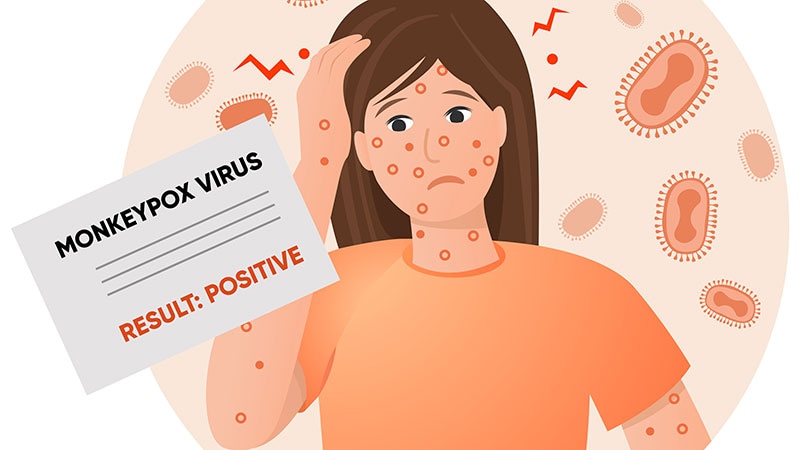Eight months have gone by since mpox (formerly known as monkeypox) first appeared outside historically endemic areas, and the focus is still largely on men who have sex with men (MSM). From a clinical perspective, it makes sense; one of the largest global case studies, which was published this past August in The New England Journal of Medicine, showed that almost 98% of confirmed mpox cases occurred in gay or bisexual men, 41% of whom were also living with HIV.
However, few surveillance studies have included women, and the ones that have did not distinguished between cis women, transgender women, and nonbinary persons assigned female at birth. This dearth of data leaves an important knowledge gap that challenges clinical and public health efforts to halt transmission and, ultimately, interrupt the virus’s evolution.
In response, a global consortium plans to change that paradigm. It has published the first case series aimed at understanding risk factors and clinical features that are potentially unique to these populations.
The study’s findings, which were published online late November in The Lancet, underscore that although clinical presentation and transmission characteristics were fairly uniform among MSM and transgender women, there were important differences in the settings in which cis women and nonbinary individuals sought care.
Moreover, different settings appeared to have an association with misdiagnoses and delayed diagnoses. And although the numbers of lesions (median = 10) were similar across patient populations and were similar to numbers seen in MSM, vaginal and anal lesions correlated directly to sexual practices.

Dr Chloe Orkin
“Our case series is important because we have considered the effects of both sex and gender on health,” co-author Chloe Orkin, MBChB, FRCP, MD, told Medscape Medical News. She is a professor of HIV medicine at Queen Mary University of London, United Kingdom, and is a consultant physician at Barts Health NHS Trust.
Orkin and her colleagues, all members of the SHARE-Net international clinical network (a collaboration established at the start of the mpox outbreak to exchange data, research, policy, and practice perspectives), contributed case-report data that focused on key drivers, including potential exposures, clinical findings, diagnosis, HIV status, concomitant sexually transmitted infections, and complications. Participating clinicians were required to designate a single suspected infection route or choose “unknown.”
Included in the study were 136 case participants (51% cis women, 46% transgender women, and 4% nonbinary persons) from 15 countries and three World Health Organization regions. Almost half (48%) were Latinx; White and Black participants made up roughly a quarter of overall cases each. The majority ― 89% ― reported having sex with men within the past month.
“We found differences in disparities and social vulnerabilities,” said Orkin, who noted that transgender women in particular were more likely to be living with HIV, engaging in transactional sexual activity, and not accessing preexposure prophylaxis (PrEP).
Overall, 27% of the study group (half of whom were transgender women) were living with HIV, but the majority of those (97%) were undergoing antiretroviral therapy, and for most (81%) for whom data were available, the virus was controlled. But among participants without HIV, only slightly more than half of transgender women (58%) were receiving PrEP, vs 2% of cis women and nonbinary individuals.
Additional social determinants of health ranged from injecting drugs and migrant or homelessness status.
Clues From Diverse Care Settings, Sexual Practices
The findings also showed that most transgender women (66%) presented to sexual health or HIV clinics, whereas their cis and nonbinary peers presented to a wider range of settings, including emergency departments (35%), sexual health or HIV clinics (24%), and other hospital departments or primary care. Misdiagnosis occurred in roughly a third (34%) of cis women and nonbinary individuals, vs 10% of transgender women, and diagnosis was delayed in as many as 37% of these populations compared to transgender women (77% of whom received a diagnosis on their first visit).
Orca points to case definitions as an underlying problem.
“Case definitions were developed early on in the outbreak and particularly identified gay and bisexual men who have sex with men as the highest-risk group correctly,” she said. “But when people presented elsewhere [ie, outside of sexual health or HIV clinics], they might not have been diagnosed,” noted Orkin, who also pointed out that European data have detailed asymptomatic cases or persons presenting with very minor symptoms or a single lesion only.

Dr Yvonne Maldonado
“I think that it’s important to always look in other populations when you see some risk for disease,” explained Yvonne Maldonado, MD, Taube Professor of Global Health and Infectious Diseases and chief of the Division of Pediatric Infectious Diseases at Stanford University School of Medicine in San Francisco, who was not involved in the case series.
Like Orkin, Maldonado noted that among MSM populations in particular, rates of exposures and infections were high. Fortunately, the rates of both exposures and infection are declining. But she emphasized that this doesn’t mean that mpox couldn’t spread into other populations, including pregnant women, cis or transgender partners, partners of MSM or others, and children.
Sexual practices contain important clues.
Among the case population, 93% had skin lesions at presentation. Perianal skin lesions were observed in 76% of transgender women (vs 24% of cis and nonbinary persons), and anorectal lesions occurred in 56% of transgender women (vs 11% of cis and nonbinary persons). On the other hand, more than half (59%) of cis and nonbinary persons had vulvar lesions, and a quarter (24%) had vaginal mucosal lesions. The findings showed that anal and vaginal sex correlated with lesions at those anatomic sites.
Nonsexual transmission routes were only reported among cis women and nonbinary persons (occupational exposure in 5%, household contact in 10%, and nonsexual close contact in 10%).
“This is a really important study,” said Maldonado. “This is exactly what happened in the late 80s and early 90s when we discovered that HIV could actually infect pregnant women and result in pediatric HIV. I’m not saying that they’re going to have the same trajectory, but I think that we need to understand these populations and make sure that we are tracking them, because there is still a risk that mpox could become endemic, [albeit] low endemic,” she said.
For clinicians, the message is clear: include mpox in the differential diagnosis for all patients presenting with the telltale rash and/or lesions.
“There comes a point when we have to start looking at the end user interfaces and who is sort of more peripheral to things but is actually an affected group,” said Orkin.
Orkin receives honoraria for lectureships and consulting on HIV from Gilead Sciences, Viiv Healthcare, Janssen Pharmaceuticals, and MSD. Maldonado sits on the safety monitoring board for Pfizer’s vaccine work.
Lancet. Published November 17, 2022. Full text
Liz Scherer is an independent journalist specializing in infectious and emerging diseases, cannabinoid therapeutics, neurology, oncology, and women’s health.
For more news, follow Medscape on Facebook, Twitter, Instagram, and YouTube.
Source: Read Full Article
